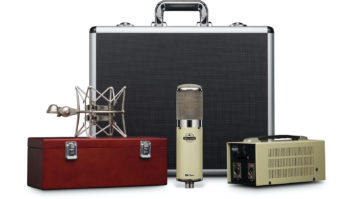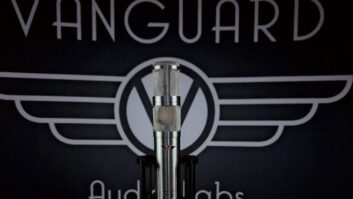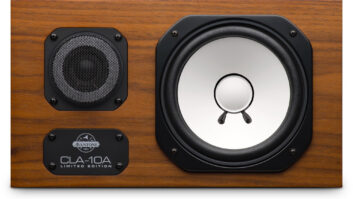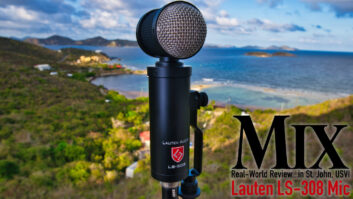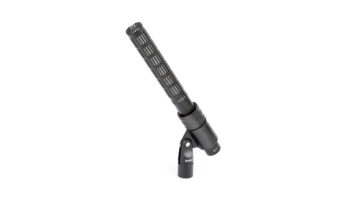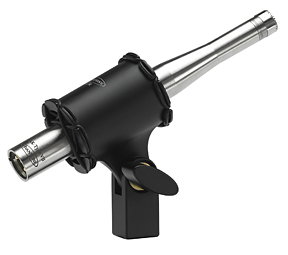
The AK-Type VII from Avantone, part of the company’s Signature Series of mics, is a hand-built omni made in limited quantities. The stainless-steel body tapers at the front, offering a slender profile that is both hefty and speaks of quality. I’m partial to mics that are easy to place by virtue of their design and mount, and the Type VII satisfies on all counts. The included banded SSM shock-mount tightly holds and isolates the mic, making it easy to sneak into tight spots. The mic ships in a nice wooden box that cradles the mic and the mount.
SMALL MIC, BIG SPLS
The mic features a medium-capsule, pre-polarized condenser element that offers 25dBA self-noise. This amount is slightly higher than I’d like in a mic used for detail work, but it worked well in all situations for this review without the noise being obtrusive. Max SPL is 160 dB, a spec that I ended up putting to the test by recording a Porsche 911 engine (more later) — all this from a mic that’s just under 6.5 inches and weighs in at just more than a third of a pound. The frequency response is almost dead-flat — nearly out to 40k — wiggling a bit past 10k but never more than ½ dB.
FROM TINKLE TO ROAR
I first heard the Avantone on various percussion elements. Its ability to take up to 160 dB makes it perfect for up-close, high-transient situations. The mic’s flat nature worked especially well for percussion. Also, the slim silhouette makes it easy to point-and-shoot it toward any source. It sounded great on shaker, bells, finger cymbals and other “tinkly” hand percussion without EQ. I never had to worry about the “nasty” side of these instruments overloading the mic, and placement was easy. When I later used it on a cajon that had considerable bottom end, however, I needed to boost the lows at about 100 Hz.
The pair offered plenty of silky top when I put them up as a spaced pair over a drum kit. The cymbals were clean and the stereo image was accurate. They were equally adept at representing the kit in the room when I set them back about five feet from the front of the kit at knee height. Once again, I found I had to kick in the bottom end a bit to get the lows to speak, but that was easy to do with SSL 4000 Series EQs.

Avant, start your engines—an AK-Type VII records a heavily modified Porsche 911 Turbo
I next used the Type VIIs as a spaced stereo pair on acoustic guitar. It brought out the sound of the pick on the strings nicely and presented an accurate stereo picture of the instrument. Its flat bottom end made it perfect for this application, not being boomy in the least. For this scenario, I prefer to use a mic that doesn’t have a bump at the bottom end rather than having to take out any boominess with EQ.
Next, I recorded an acoustic guitar pointing the mic directly where the sound hole meets the neck, about nine inches back. This setup is tricky because even a slight alteration in placement can change the personality of the recording. In this case, I captured a nice even top that wasn’t overbearing and had plenty of bottom, although it was a bit boxy. As an experiment, a Retro Sta-Level compressor (see page 98 for the Sta-Level “Field Test”) was put across the insert and set to a medium attack and release. This immediately brought out more of the silky Type VII top and tightened up the bottom. With the mic’s natural top-end boost, it was easy for the Retro to dig out that info from the existing recording.
START YOUR ENGINES!
I was able to hear the mics employed in a recording of a heavily modified Porsche 911 Turbo at Xact Dyno in Arizona. The mics were placed on stands in the engine compartment, literally inches from whirring engine parts. The recording was for use in a videogame, so sustained rpm was the order of the day, which was achieved by putting the car up on a dynameter and then revving it at different levels with and without load. Various mics were used, including our intrepid Type VIIs, all sent through an Aphex 1788 remote-controlled mic preamp. The SPL handling capabilities of the Type VII made it a great choice for a situation where the dynamics of an engine on a dyno could easily cripple a mic with lesser ability. The mics stood up to the task, producing plenty of clean signal, even out to ear-splitting rpms.
IS VII HEAVEN?
The Type VII excels in a number of areas. First, it’s small and easy to work with. Its response is flat at the bottom, so be warned that there is not a lot of help at that end of the spectrum. You’ll need to boost some bottom if that’s what you’re looking for. The natural-sounding, flat top end out to 40k helps with percussion and other applications where you need the top end smooth and natural.
It was nice to put the mic into extreme circumstances with the recording of a roaring performance engine on a dyno for use in a videogame. It handled all the SPL that the engine could put out without a complaint. At a price of $599, and with this kind of versatility, the Avantone AK-Type VII is worthy of a listen, whether you’re recording race cars or not.
Avant Electronics, 909/931-9061, www.avantelectronics.com.
Kevin Becka is Mix’s technical editor.
